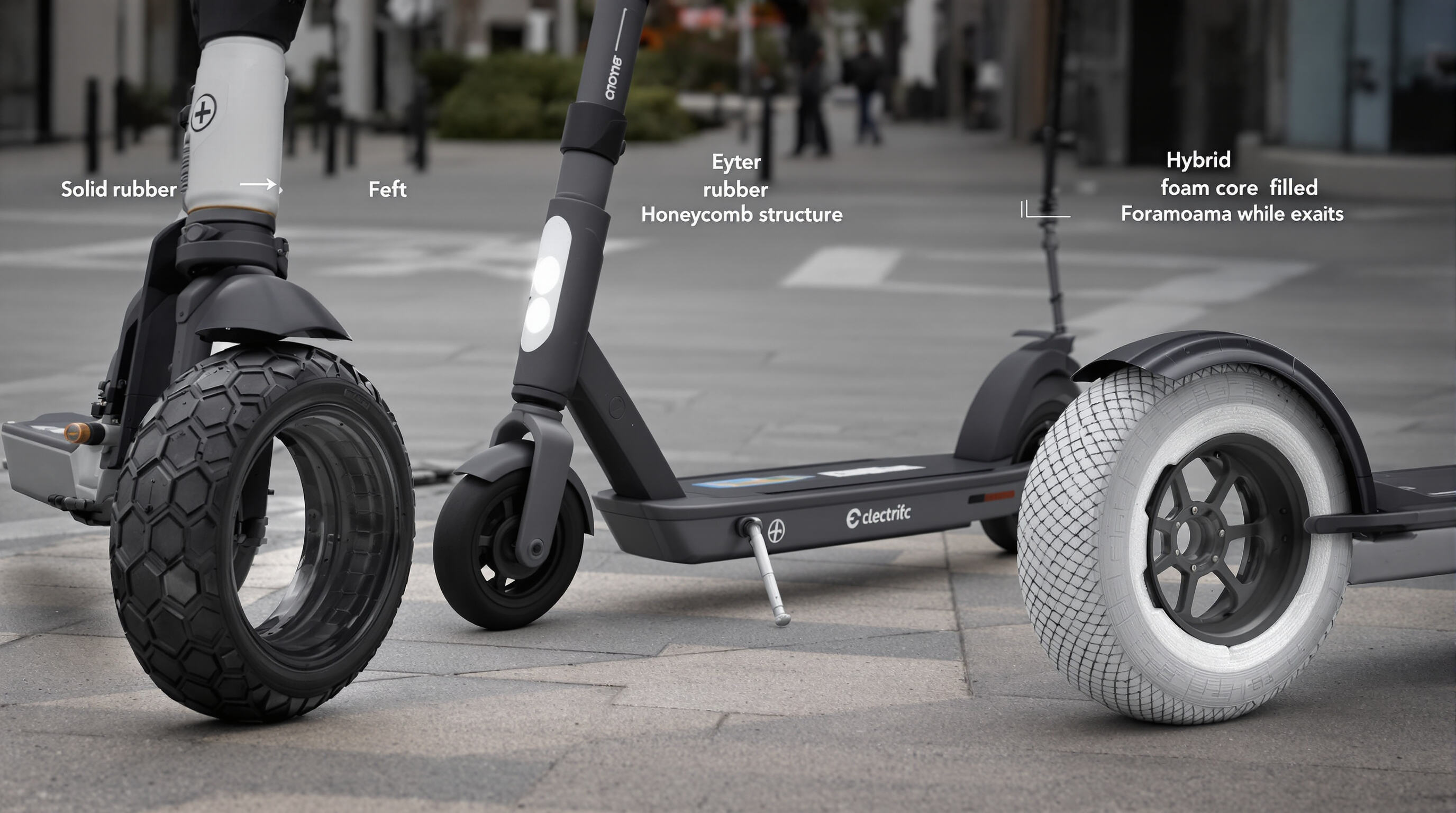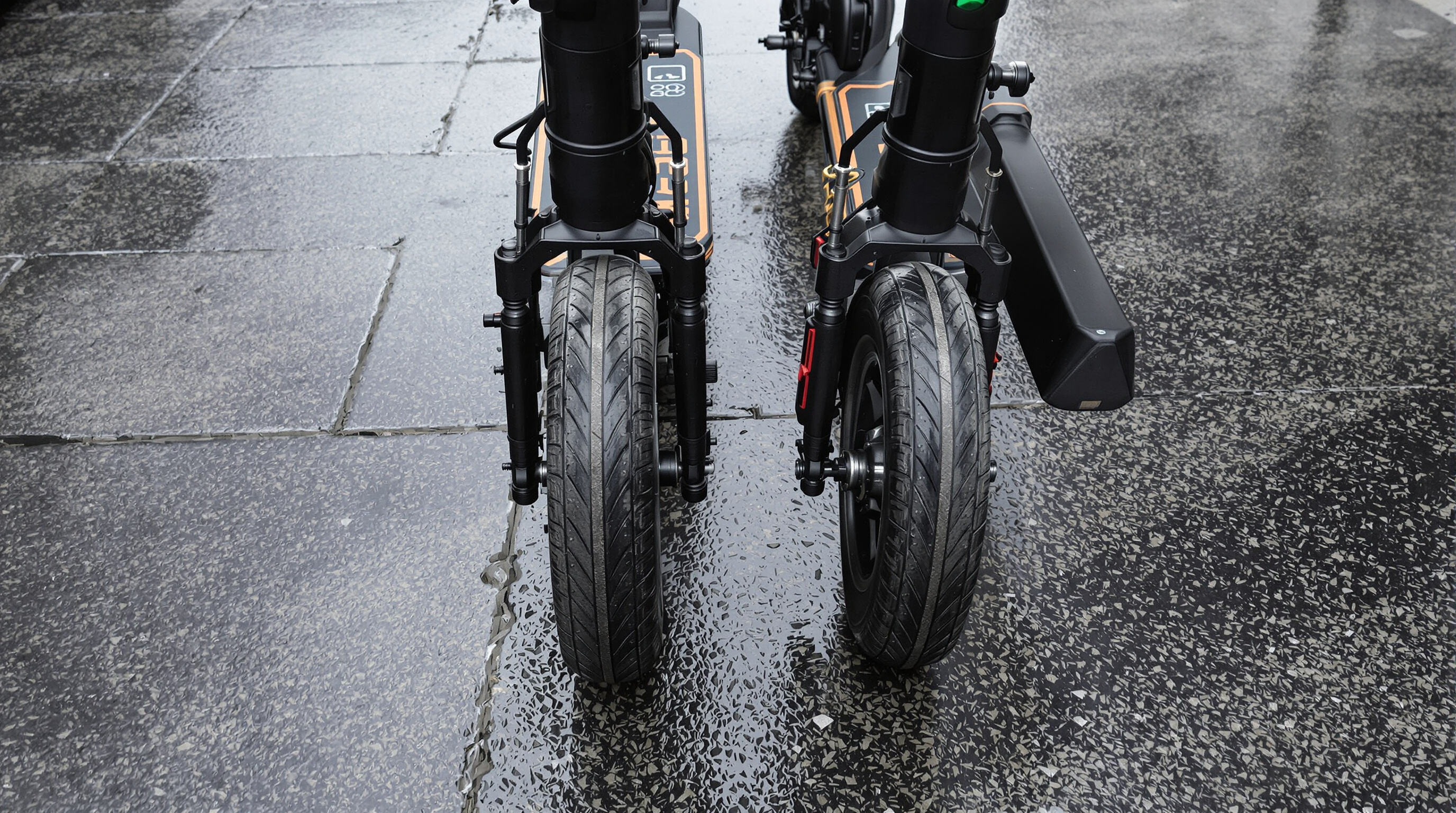Around 38 percent of all unexpected maintenance expenses for scooter companies come from flat tires, according to the Fleet Efficiency Report released last year. Fixing these flats typically runs between eighty five and one hundred twenty dollars each time they happen. The old style air filled tires need constant replacement of inner tubes, plus special equipment and technicians who travel around to fix them. These costs really add up when looking at big fleets with hundreds or even thousands of scooters on the road. When just one tire goes down, it takes anywhere from three to seven whole hours before that scooter is back in service again. This creates serious problems for businesses operating in busy city centers where customers expect immediate availability of vehicles.
Each hour of downtime reduces per-scooter revenue by $9–$15 in peak markets. Fleets of 500+ units lose over 12,000 ride hours monthly due to tire-related issues, according to micromobility telemetry data. Puncture-proof tire systems reduce roadside repairs by 89%, significantly increasing vehicle availability during critical usage periods.
When it comes to maintenance money pits, damaged tires take the cake, beating out battery problems at 22% and brake troubles at 18%. Recent research looked at around 4,200 scooters and discovered something interesting about those newfangled airless tires. They really do work wonders, slashing how often these vehicles need to visit repair shops for tire issues down dramatically—from about once every month to just three times a month on average. Imagine running a fleet with 500 scooters? That kind of improvement adds up fast. We're talking roughly $28k saved each year when factoring in all those fewer mechanic hours and spare parts needed.

Solid rubber tires don't get flats at all and can take a real beating from curbs and stuff lying around city streets. They tend to last about two to three times longer than regular air-filled tires. But there's a catch. Because they're so stiff, they transmit a lot more road vibrations, which means folks generally find them less comfortable to ride on. According to a recent survey in the micro mobility space back in 2023, roughly seven out of ten riders said these solid rubber tires felt uncomfortable when riding over rough terrain such as bricks or cobblestones. Makes sense really, since nobody wants to feel every little bump in the road while trying to get somewhere quickly.
Honeycomb designs use geometric airless structures to absorb 40% more shock than solid rubber in lab tests. The hexagonal cells compress under load, improving ride quality. However, the open-cell design can trap debris, requiring weekly pressure-washing in high-litter environments. Coastal fleets report 22% faster wear due to salt and sand exposure.
Foam-filled hybrids combine sealed air chambers with urethane foam cores, offering 90%+ puncture resistance in nail-bed tests while weighing 15–18% less than solid rubber. They provide a middle ground in performance but face challenges with heat buildup; after 8 hours of continuous summer use, foam softening can reduce wet-surface traction.
Innovations from leading material science companies include gradient-density polymers and 3D-printed treads. One next-gen design uses interlocking resin spokes that flex like pneumatic tires while remaining maintenance-free. Though 35–50% more expensive upfront, early fleet trials show these tires reduce total ownership costs by 19% over 18 months due to fewer replacements.

Puncture-proof tires offer 22% better wet-surface traction than pneumatic models in independent testing (Urban Mobility Report 2023). Engineered tread patterns and composite materials maintain grip on rain-slicked lanes and cobblestone. However, pneumatic tires still reduce rider discomfort by 33% on rough terrain due to natural shock absorption.
An 18-month study of 1,200 shared scooters showed puncture-proof tires last 2.3 times longer than pneumatic ones in dense urban settings:
| Metric | PunctureProof Tires | Pneumatic Tires |
|---|---|---|
| Average lifespan | 2,800 miles | 1,200 miles |
| Road debris failures | 0.3% | 14.7% |
| Replacement labor cost | $9.50/mile | $23.80/mile |
Pneumatic tire degradation was primarily linked to repeated inflation cycles and patch repairs.
Puncture-proof tires score 15% lower in rider comfort surveys compared to pneumatic models (Shared Mobility Insights 2024). Hybrid designs—such as foam-filled honeycomb structures—achieve 87% of pneumatic tires’ vibration dampening while maintaining puncture resistance. Fleets using these hybrids report a 19% drop in comfort-related complaints versus solid rubber alternatives.
The MetroGlide Airless Pro uses industrial-grade polymers and a radial web design to deliver over 14,000 miles of service life. Its seamless construction prevents pinch flats and retains 85% of pneumatic tire shock absorption, helping protect onboard electronics. Operators report 63% fewer tire-related service tickets compared to foam-filled models.
Weighing 23% less than standard solid tires, EcoRide SolidCore reduces motor strain without sacrificing durability. Its thermoplastic compound withstands continuous 140°F surface temperatures, making it ideal for tropical climates. Sidewall grooves enhance wet-weather grip, addressing safety concerns in rainy urban environments.
Used by 9 of the top 15 shared mobility operators, UrbanShield X3 features a replaceable tread layer that extends core lifespan by 300%. The modular design allows fleet technicians to replace worn sections in 8 minutes—far faster than the 35 minutes typically needed for full tire swaps—streamlining maintenance during high-usage periods.
| Model | Initial Cost | Miles Until 20% Tread Loss | Cost/Mile |
|---|---|---|---|
| Premium Airless | $89 | 9,200 | $0.0097 |
| Hybrid Foam-Filled | $67 | 6,500 | $0.0103 |
| Advanced Honeycomb | $102 | 12,000 | $0.0085 |
Data from 2023 fleet trials show honeycomb designs deliver the lowest cost per mile despite higher initial investment. Weight-optimized models also reduce energy consumption by 11–18%, contributing to additional operational savings.
When companies want to switch their vehicle fleets over to new technology, they need to check if rims will work properly and make sure motors can handle the different torque requirements. According to a study done last year, around 89 out of every 100 attempts at putting airless tires on scooters that were built for regular pneumatic tires actually worked out pretty well. There are several important things to do during this process. First off, it makes sense to upgrade those tire pressure monitoring systems so they can accurately detect any issues with the structure of these airless tires. Mechanics also need special training because there's something different about how much force is needed when installing these puncture proof versions compared to traditional ones. And finally, most experts recommend rolling out changes gradually rather than all at once. That way, anyone running the operation can keep an eye on vibrations and see how brakes perform after installation. Some big transportation companies across Europe have told stories about getting their money back within just six to eight weeks thanks to not having to replace tires as often anymore.
A scooter company operating out of Lisbon cut down on monthly maintenance work by around 220 hours when they switched about 60 percent of their 1,500 scooters to those special honeycomb tires that don't go flat. During busy summer months when tourists flock to the city, there were roughly two thirds fewer tire changes needed. Mechanics could get scooters back on the road much quicker too since they no longer had to check air pressure, cutting redeployment time by almost half. Plus, drivers called for help less often, down about 17 percent from before. Most importantly, the company put those extra hours toward taking better care of batteries and brakes across the whole fleet, which means fewer breakdowns and happier customers riding around town.
Puncture-proof scooter tires are designed to eliminate the common issue of flat tires by using solid rubber, honeycomb structures, or foam-filled hybrids instead of traditional air-filled tubes.
Puncture-proof tires significantly reduce maintenance costs associated with tire repairs and replacements, thereby increasing the operational efficiency of scooter fleets.
While puncture-proof tires offer durability, some designs like solid rubber can reduce ride comfort due to increased road vibration. Hybrid and honeycomb designs aim to balance durability and rider comfort.
Puncture-proof tires can be used in various environments, but certain designs may require maintenance such as pressure washing in high-debris areas or may experience faster wear in coastal conditions.
 Hot News
Hot News
© Copyright 2024 Shenzhen New Image technology Co., Ltd All Rights Reserved Privacy policy